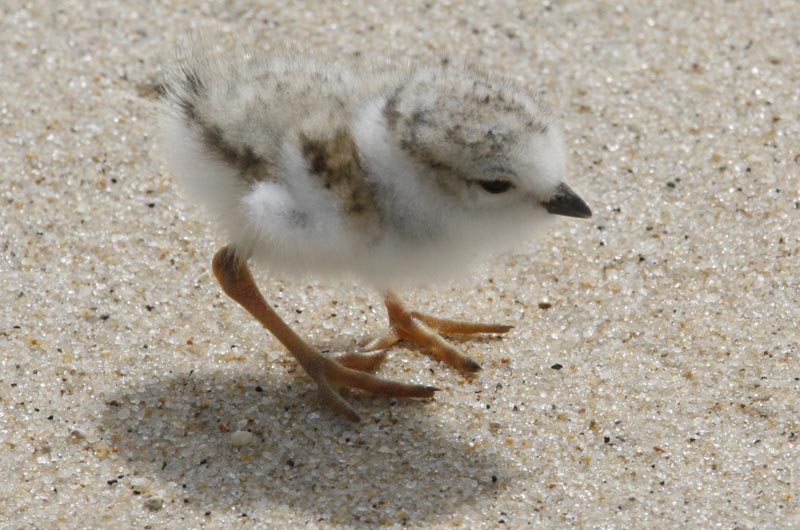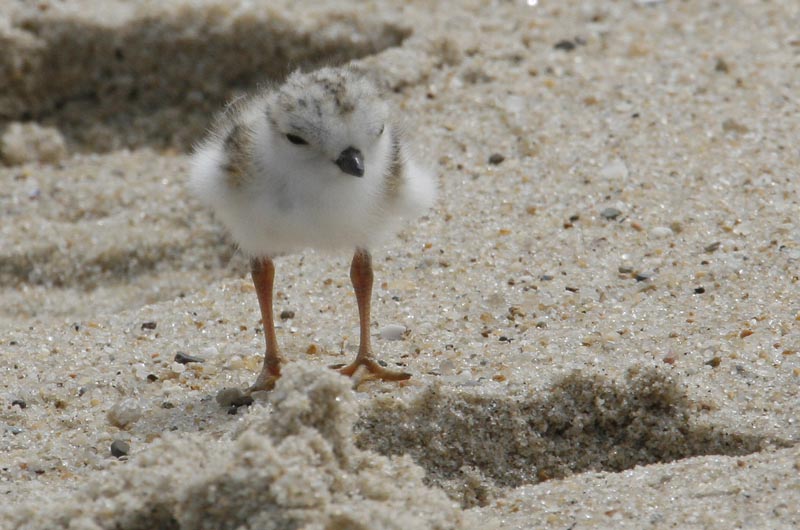While winter storms have Vineyarders hunkering down indoors and threatened some waterfront homes, they’ve been a boon to nesting piping plovers, who prefer the scoured beaches left by storms and hurricanes. But this year’s population of the tiny migratory shorebirds, down slightly at about 50 pairs according to Island organizations, still face challenges from predators, human traffic and continuing storms. Beginning this week, some Island beaches were closed to protect nesting and fledgling plovers.
Also abundant this week, though far less welcome, were Portuguese man-of-wars, stinging siphonophores that washed up on several south-facing beaches.
Piping plovers are a state and federally protected species. The small shorebirds like to make their nests in tiny scrapes on exposed, remote barrier beaches. BiodiversityWorks, a conservation group that works on shorebird monitoring and protection, is looking after 25 nesting pairs of piping plovers. Mass Audubon has seven pairs of piping plovers on its beaches, while Sheriff’s Meadow Foundation reported three pairs of the birds and the Martha’s Vineyard Lank Bank reported two. The Trustees of Reservations reported 11 nesting pairs.
The total — about 48 pairs — is a positive sign for a species that has faced dwindling numbers, though some said the total is slightly lower than last year. In 2008, there were an estimated 24 nesting pairs on the Island. A 2011 state piping plover census, the most recent available, listed between 49 and 58 nesting pairs on the Island. The census listed an adjusted total of 656 pairs in Massachusetts.
Piping plovers usually lay four eggs at a time, according to Luanne Johnson of BiodiversityWorks, and each egg is 10 per cent of the female plover’s body weight.“These birds invest in the eggs,” she said, making each egg particularly valuable. The eggs are incubated for 26 days before they hatch, with the precocious chicks born ready to forage for invertebrate meals. With meal duty out of the way, parents “brood, keep them dry in the rain, warm them when cold, shelter when it’s hot,” Ms. Johnson said. “It’s a big investment in eggs.”
Piping plovers mate for life. The goal is to have an average of 1.34 chicks fledge per nesting pair to maintain the population, Ms. Johnson said, noting that coastline development, urbanization and predators have hurt piping plover populations.
On the Vineyard, egg predators are mainly skunks and crows, Ms. Johnson said. Exclosures, covered circular wire fencing about 10 feet across, guard against predators and increase hatching success to about 90 per cent while allowing the birds to go in and out to access food. But exclosures are not foolproof, Ms. Johnson said. Some smart predators, like crows, have caught on to the idea, and wait outside for the chicks to leave, or perch on the rim and make noise, causing the plovers to abandon their nests. “We use it carefully these days,” she said.
Hatched chicks and adult plovers face a host of other predators besides skunks and crows, including humans stepping on them, dogs trampling and eating them, feral and outdoor house cats, some gulls, oystercatchers, hawks, falcons and rats.
And while storms create ideal plover habitat, torrential downpours pose problems for the fledglings. “The rain is tough on them, Ms. Johnson said, though they “have had chicks make it through these [storms] so far.”
The population is thriving in spite of, and perhaps because of, the frequent storms this winter. Ms. Johnson noted that with the storms, plovers have “lost habitat in some areas, gained it in other areas. There’s always kind of interplay every season, it’s really what they’re adapted to do.
“They love a beach that’s been blasted by a hurricane. They love blowouts in dunes. Those events are pretty natural for them,” she said, as long as beach revetments and developments don’t disrupt natural processes.
Ms. Johnson said late May storms caused some nests to be overwashed. Right now five pairs are re-nesting after losing nests to predators or tidal overwash.
In some cases, overwash scatters the precious eggs on the beach. If possible, she said, the birds will remake the nest, rolling the eggs back by using their little beaks.
“I’ve seen many of those nests hatch,” Ms. Johnson said.
“Birds are sort of resilient to that,” she said, as long as there is habitat available above the high tide line. She noted that one couple made a scrape in a cave-like enclosure between a steep dune bank and dead hanging dune grass. “These birds have been nesting [on these beaches] for so many years. [Hurricane] Sandy really scoured the beach and changed it quite dramatically . . . I’ve seen pairs that have been very successful hanging on to a site and adapting.”
A recovery goal of 2,000 pairs between South Carolina and Nova Scotia has not been reached, Ms. Johnson said. “Every pair counts.”
Chris Kennedy, Vineyard superintendent for The Trustees of Reservations, reported that piping plovers are nesting in large numbers this year at Cape Pogue Wildlife Refuge on Chappaquiddick, on Leland Beach north of the Dike Bridge, and at Norton Point.
“We have two families of chicks at the Gut, one plover nest at the elbow, two nests north of the Dike Bridge, one family of chicks running up and down East Beach, two nests on Leland Beach, one nest at Norton Point and two families at Norton Point,” Mr. Kennedy said. “They’re everywhere.”
In a statement released late last week, the Trustees announced that while much of Cape Pogue and Norton Point has been closed to oversand vehicles to protect plover nests and chicks, after a detailed habitat study, the state Division of Fish and Wildlife and U.S. Fish and Wildlife will allow limited areas to remain open to vehicles.
About 5,000 feet of the Leland Beach bayside trail and about half the bayside trail north of the Dike Bridge are considered unsuitable foraging habitat for adults and chicks. “Thus, in these areas we may detour OSV traffic along the bayside trails when the bayside habitat is unsuitable for foraging by rare shorebirds or if a physical barrier exists (i.e. heavy tree/shrub vegetation) that precludes their ability to cross the barrier beach,” the statement said.
As an added protection measure, dogs are seasonally prohibited on some Trustees beaches, including at the Gut, portions of Norton Point Beach and all of Leland Beach. Dogs are not even allowed on leashes or in vehicles in these areas from May 1 until mid-August.
The Trustees are also warning swimmers and beach visitors about the venomous Portuguese man-of-wars that were found washed up on the south shore of the Vineyard this week. The Trustees posted warning notices at Norton Point beach in Edgartown, and the creatures, some a translucent blue in color and others purple, were also in the Menemsha Channel and in large numbers by Squibnocket.
“We are going to be putting up signage warning people they are back,” said Mr. Kennedy said. “We are finding them primarily on the south side, but it will not be unusual to find them at East Beach too.”
He said it is early to find man-of-wars, which ordinarily wash up on beaches in the warmer months.
“They’re not uncommon, but we usually don’t see them until late summer,” Mr. Kennedy said. “I think there may be a warm core eddy that is pushing them in.”
The Portuguese man-of-war is often called a jellyfish, but in fact it is a siphonophore, an animal made up of a colony of organisms working together. It derives its name from the gas-filled bladder that sits above the water and resembles an old warship under sail. The tentacles are covered with venom-filled nematocysts that the animal uses to paralyze and kill other fish and small sea creatures. It can deliver a painful sting to humans, either in the water or walking barefoot on the beach. The long, thin tentacles can be 30 to 40 feet in length.
For most conservation groups, however, focus remains on the shorebirds. Besides piping plovers, there are reports of other endangered species: Ms. Johnson reporting that BiodiversityWorks is observing more than 500 pairs of least terns incubating eggs around the Island, including 300 pairs in what she called a “beautiful colony” at Little Beach in Edgartown. That area also has nesting pairs of oystercatchers.
Suzan Bellincampi, director of Mass Audubon’s Felix Neck Wildlife Sanctuary, said her sanctuary has a couple colonies of terns, and a very small community of least terns, as well as 11 pairs of oystercatchers hatching chicks. “Oystercatcher chicks are all over the place,” she said, with the first chicks just learning to fly.
“We have a few less plovers than we’ve had in the past,” Ms. Bellincampi said, noting some depredation.
“There’s a lot more habitat than there has been in the past,” she added, noting overwash from storms in areas like State Beach. But predators still abound. “It’s a challenge for these little guys.”
Land bank ecologist Julie Russell reported three nesting pairs on land bank beaches, noting that pairs at Tisbury Great Pond are being monitored in a roped-off area.
Thing were rough this year for a piping plover pair nesting at Cedar Tree Neck Sanctuary, Sheriff’s Meadow Foundation executive director Adam Moore said. The male appears to have been eaten by a feral cat, while all four chicks were eaten by crows.
But life begins anew. The female found another male, Mr. Moore said, and they might be trying to nest.









Comments (5)
Comments
Comment policy »